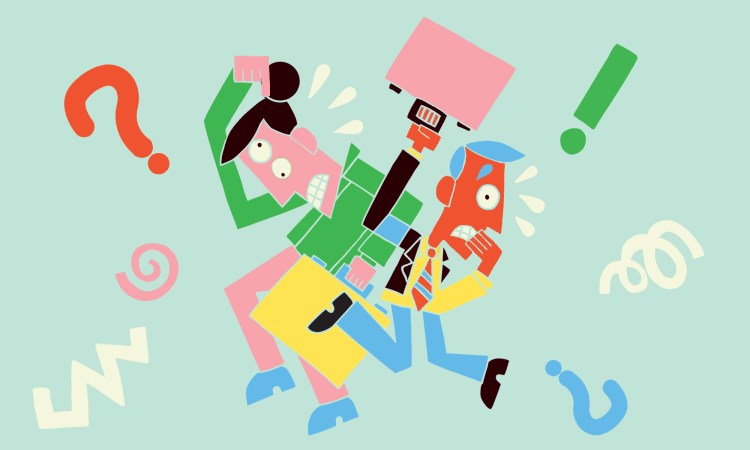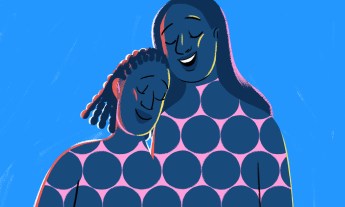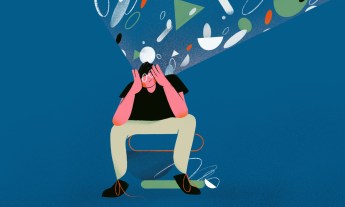
By more clearly identifying our feelings or by recategorizing them, we can reduce suffering (yes!) and increase well-being, says neuroscientist Lisa Feldman Barrett.
“He’s an angry person”; “I’m a very anxious person.” We’ve all made statements like these. They point towards the belief that emotions are hardwired in our brains or automatically triggered by events. But after decades of research at Northeastern University, neuroscientist Lisa Feldman Barrett has come to a different conclusion: “Your brain’s most important job is not thinking or feeling or even seeing, but keeping your body alive and well so that you survive and thrive … How is your brain able to do this? Like a sophisticated fortune-teller, your brain constantly predicts. Its predictions ultimately become the emotions you experience and the expressions you perceive in other people.” (For an overview of her theory, watch her TED Talk.) And that’s good news: Since our brain essentially constructs our emotions, we can teach it to label them more precisely and then use this detailed information to help us take the most appropriate actions — or none at all. Here, she explains how to do this.
One of the best things you can do for your emotional health is to beef up your concepts of emotions. Suppose you knew only two emotion concepts: “Feeling Awesome” and “Feeling Crappy.” Whenever you experienced an emotion or perceived someone else as emotional, you’d categorize only with this broad brush, which isn’t very emotionally intelligent. But if you could distinguish finer meanings within “Awesome” (happy, content, thrilled, relaxed, joyful, hopeful, inspired, prideful, adoring, grateful, blissful . . .), and fifty shades of “Crappy” (angry, aggravated, alarmed, spiteful, grumpy, remorseful, gloomy, mortified, uneasy, dread-ridden, resentful, afraid, envious, woeful, melancholy . . .), your brain would have many more options for predicting, categorizing and perceiving emotions, providing you with the tools for more flexible and useful responses. You could predict and categorize your sensations more efficiently and better suit your actions to your environment.
People who can construct finely-grained emotional experiences go to the doctor less frequently, use medication less frequently, and spend fewer days hospitalized for illness.
What I’m describing is emotional granularity, the phenomenon that some people construct finer-grained emotional experiences than others do. People who make highly granular experiences are emotion experts: they issue predictions and construct instances of emotion that are finely tailored to fit each specific situation. At the other end of the spectrum are young children who haven’t yet developed adult-like emotion concepts and who use “sad” and “mad” interchangeably. My lab has shown that adults run the whole range from low to high emotional granularity. So, a key to real emotional intelligence is to gain new emotion concepts and hone your existing ones.
Perhaps the easiest way to gain concepts is to learn new words. You’ve probably never thought about learning words as a path to greater emotional health, but it follows directly from the neuroscience of construction. Words seed your concepts, concepts drive your predictions, predictions regulate your body budget (which is how your brain anticipates and fulfills your body’s energy needs), and your body budget determines how you feel. People who exhibit higher emotional granularity go to the doctor less frequently, use medication less frequently, and spend fewer days hospitalized for illness. This is not magic; it’s what happens when you leverage the porous boundary between the social and the physical.
Higher emotional granularity has many other benefits for a satisfying life. In a collection of scientific studies, people who could distinguish finely among their unpleasant feelings — those “50 shades of feeling crappy” — were 30 percent more flexible when regulating their emotions, less likely to drink excessively when stressed, and less likely to retaliate aggressively against someone who has hurt them. For people who suffer from schizophrenia, those who exhibit higher emotional granularity report better relationships with family and friends, compared to those who exhibit lower granularity, and are better able to choose the correct action in social situations.
So, learn as many new words as possible. Read books outside of your comfort zone, or listen to thought-provoking audio content like National Public Radio. Don’t be satisfied with “happy”: seek out and use more specific words like “ecstatic,” “blissful” and “inspired.” Learn the difference between “discouraged” or “dejected,” versus the generic “sad.” And don’t limit yourself to words in your native language. Pick another language and seek out its concepts for which your language has no words, like the Dutch emotion of togetherness, gezellig, and the Greek feeling of major guilt, enohi. Each word is another invitation to construct your experiences in new ways.
By coming up with your own emotion concepts, you’ll be better calibrated to cope with different circumstances and potentially more empathic to others.
Try also to invent your own emotion concepts, using your powers of social reality and conceptual combination. The author Jeffrey Eugenides presents a collection of amusing ones in his novel Middlesex, including “the hatred of mirrors that begins in middle age,” “the disappointment of sleeping with one’s fantasy,” and “the excitement of getting a room with a minibar,” though he does not assign them words.
You can do the same thing yourself. Close your eyes and imagine yourself in a car, driving away from your hometown, knowing you will never return. Can you characterize that feeling by combining emotion concepts? If you can employ this technique day to day, you’ll be better calibrated to cope with varied circumstances, and potentially more empathic to others, with improved skill to negotiate conflict and get along. You could even name your creations and teach them to your family and friends.
An emotionally intelligent person not only has lots of concepts but also knows which ones to use and when. Just like painters learn to see fine distinctions in colors that others cannot, you can practice the skill of categorizing. Suppose you see your teenage son heading to school looking like he just rolled out of bed: hair unkempt, clothing wrinkled, and last night’s dinner dotting his shirt. You could berate him and send him back to his room to change, but instead, ask yourself what you are feeling. Are you concerned that his teachers won’t take him seriously? Nervous that his attire will reflect badly on you as a parent? Irritated that you spend money on clothes he never wears? Or, perhaps you’re sad that he’s grown up and you miss the exuberance of his childhood. Depending on the answer, you can come up with a much more skillful response than just yelling at him.
In one study, fine-grained categorization was the most effective in helping people with arachnophobia to be less anxious when observing a spider and to approach spiders.
If all this introspection sounds unnecessary, realize that people pay good money to therapists and life coaches for exactly this purpose: To help them reframe situations. They enlist these practitioners to help them find the most useful categorizations so they can choose the most appropriate actions to take. You can do this yourself and become an expert categorizer of emotion with enough practice, and you’ll find it gets easier with repetition.
In a study about fear of spiders, fine-grained categorizations have been shown to beat two other popular approaches for “regulating” emotions. The first approach, called cognitive reappraisal, taught subjects to describe the spider in a nonthreatening way: “Sitting in front of me is a little spider, and it’s safe.” The second approach was distraction, having the subjects pay attention to something completely unrelated. The third approach was to categorize sensations with greater granularity, such as: “In front of me is an ugly spider and it is disgusting, nerve-wracking, and yet, intriguing.” It was the most effective in helping people with arachnophobia to be less anxious when observing a spider and to approach spiders. What’s more, the effects lasted a week beyond the experiment.
When people speaking in public recategorize their anxiety as excitement, their sympathetic nervous system still creates jittery butterflies but with fewer cytokines that lower performance so they perform better.
Besides practicing emotional granularity, another effective way to master your emotions is to recategorize how you feel. Anytime you feel miserable, it’s because you are experiencing an unpleasant effect due to physical sensations. Your brain will try to predict causes for those sensations, and the more concepts you know and the more instances you can construct, the more effectively you can recategorize to manage your emotions and regulate your behavior. For instance, if you’re about to go in for a job interview and feel your heart racing, you might categorize your sensations as harmful anxiety (“Oh no, I’m doomed!”) or as helpful anticipation (“I’m energized and ready to go!”). The head of my daughter’s karate school advises his students before their black belt test: “Make your butterflies fly in formation.” He is saying, Yes, you feel worked up but don’t perceive it as nervousness: construct it as determination.
Recategorization of this kind can bring tangible benefits. People who recategorize anxiety as excitement show positive effects, with better performance and fewer classic symptoms of anxiety when speaking in public and when singing karaoke. Their sympathetic nervous system still creates the jittery butterflies, but with fewer of the proinflammatory cytokines that lower performance and generally make people feel bad, so they perform better. Studies have shown that remedial math students at community colleges can improve their exam grades and their final course grade through effective recategorization.
Whenever you feel that you’re suffering or some insult has befallen you, ask yourself some questions. Are you really in jeopardy? Or is this so-called injury merely threatening your social reality ? Could this feeling have a purely physical cause? The answer can help you recategorize your pounding heartbeat, the knot in the pit of your stomach and your sweaty brow as purely physical sensations, leaving worry, anger and dejection to dissolve like an antacid tablet in water.
I’m not saying this kind of recategorization is easy, but with practice it’s possible and it’s also healthful. When you can categorize something as “not about me,” it exits your affective niche and has less impact on your body budget. Similarly, when you are successful and you feel proud, honored or gratified, take a step back and remember that these pleasant emotions are entirely the result of social reality, reinforcing your fictional self. In other words, celebrate your achievements, but don’t let them become golden handcuffs.
Excerpted from the new book How Emotions Are Made: The Secret Life of the Brain by Lisa Feldman Barrett. Copyright © 2017 by Lisa Feldman Barrett. Used with permission from Houghton Mifflin Harcourt Publishing Company. All rights reserved.












